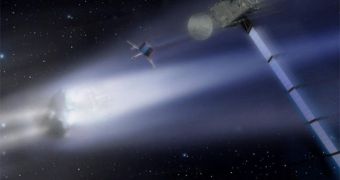A team of experts has recently refined a series of astronomical calculations, and determined that the best solution to approach a comet before landing on it is from the south, and with caution.
The research is published four years ahead of a planned rendezvous between the Rosetta probe, built by the European Space Agency (ESA) and the Comet 67P/Churyumov-Gerasimenko.
The spacecraft was launched in 2004, which means that it has already been chasing its target for about six years. The new work confirms previous researches into how to attack comets once we catch up with them.
Once it reaches it target, Rosetta will drop the lander Philae on the southern half of the space object, researchers say. It would appear that this is the best thing to do, the new research also reports.
According to investigators behind the new study, these data could be used to further refine the path that Philae will take after separating from its mother ship, Space reports.
“Southern sites appear to be both the safest and the most scientifically interesting,” explains in a statement expert Jeremie Lasue, who is a coauthor of the new investigation.
He holds an appointment as a research scientists at the the US Department of Energy's (DOE) Los Alamos National Laboratory (LANL). The expert says that the two spacecrafts will keep an eye on the comet for about 13 months.
In 2014, when Rosetta is scheduled to catch up with Comet 67P/Churyumov-Gerasimenko, the space rock will be hurtling towards the Sun.
After spending about 1 year studying it, the spacecraft will end its mission, as the comet spins around the Sun, and then starts heading back to the outer fringes of the solar system.
“From our present results, we've concluded that the southern hemisphere promises the best landing sites,” explains scientist Maria Cristina De Sanctis.
She was also a researcher on the new study. The expert is based at the Istituto Nazionale di Astrofisica's Istituto di Astrofisica Spaziale e Fisica Cosmica, in Rome, Italy.
“As more data on Churyumov-Gerasimenko becomes available to better quantify our results, we will be able to add to the picture and help prepare for a safe landing for Philae,” she goes on to say.
The group behind the new investigation presented its conclusions at the European Planetary Science Congress, on September 23. The meeting is being held in Rome.

 14 DAY TRIAL //
14 DAY TRIAL //